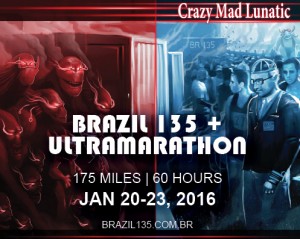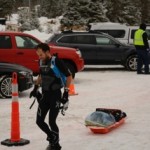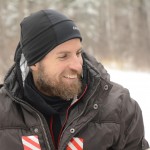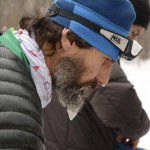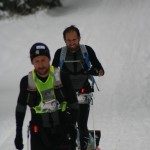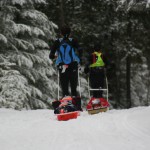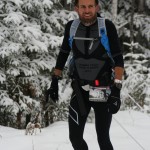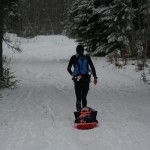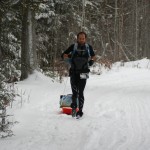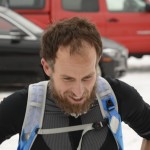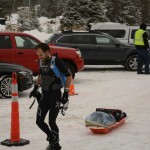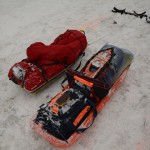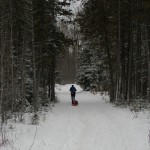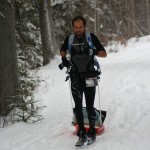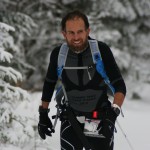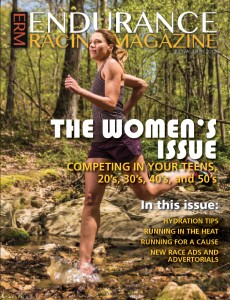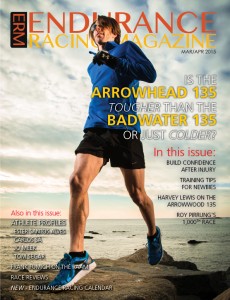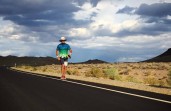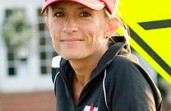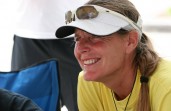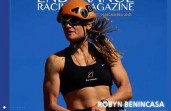- Harvey and his father, Harvey
- These sleds weigh a LOT (40 lbs or more)
- Harvey competes at the Arrowhead 135.
Beware of the Yeti
The Arrowhead 135 – Legend of the Northwoods
By Harvey Lewis
There is a legend and mystique to the Arrowhead 135. In the far northern stretches of Minnesota, just below the Canadian border, athletes have descended annually in the dead of winter upon International Falls, otherwise known as “Frostbite Falls”, for a race that will challenge even the most seasoned ultrarunner.
This past July I won the Badwater 135, listed by National Geographic as first on the list of the top ten toughest races on the planet. I have raced Badwater the past four years, drawn to it due to the extremes in temperature (Death Valley reached 134 degrees in 1913). The challenge of running 135 miles over three large mountains in one of the most picturesque places on the planet was also a tremendous draw. After winning Badwater, I wanted a new challenge – one that would require a new set of skills and would push me.
The Arrowhead 135 is the antithesis of Badwater. The Arrowhead Range is known for having some of the coldest winter temperatures on the planet (Tower, Minn., where the race finishes, holds the Minnesota record of -60 degrees in 1996). It’s incredible to imagine that air temperatures have ranged as much as 190 degrees between these two distinct lands – and that’s not taking into account the potential for wind chill or the super-heated blacktop in Death Valley that generates temperatures hot enough to melt shoe soles. I would be lying if I said the extreme cold didn’t leave me a bit on edge throughout the period of preparation. Additionally, unlike Badwater, where athletes have a crew to refuel them, the Arrowhead requires athletes to receive no outside assistance whatsoever. Athletes must carry all of their own materials, outside of what they might purchase at the one store (mile 36, Gateway Store, aid station one) and a 15-pound drop bag (mile 70, MelGeorge’s Resort). The final aid station is at mile 110, referred to as Ski Polk, that is expected to carry only water. There are three aid stations for the 135 miles to Fortune Bay Casino. Athletes have 60 hours to complete the race.
The Arrowhead 135 required a lot of research and gear. I read through many of the blogs and articles on the race website. I remember seeing the Arrowhead 135 advertised on the site as among the top 50 most difficult races. Parker Rios, a race veteran, was extremely helpful in giving me feedback on equipment and any questions related to the race. Parker, like many racers, dropped out his first year. He went on to win in 2013, an extremely demanding year with more than 10 inches of snow. I knew I had to exercise caution or I risked a DNF as well. Over the years, fewer than half of the racers have finished and the weather conditions can change substantially year to year. The Arrowhead is not cheap. The mandatory gear list and demands of the course required a -20 sleeping bag, sled with harness, and extreme weather apparel.
I love the heatI don’t love the cold! I enjoy snow and winter scenery, but for decades I have internally bantered about the cold. I had to change my psychology. Typically, every winter I sign up for the local gym and watch movies three or four days a week while running on a treadmill to supplement my miles outside. This winter, I very rarely ran inside. I conditioned my mind to enjoy the cold. Once a week, I would run with less clothing than the weather demanded for a short set. I also took some cold showers and developed a cold weather mantra, telling myself, “I love the winter. I’m an arctic fox.” The strategy seemed to work; I became more immune to the cold. I really enjoyed running back and forth to work each day in it.
The challenge in my hometown of Cincinnati, Ohio this winter prior to the Arrowhead on January 26th was that we had only one small snowfall in November. I didn’t get to practice with my sled once. But it helped speaking with Parker Rios and trying to understand the best formula. I pulled a tire some, as I had in past years training for Badwater. I ran along the rocky shoreline of the Ohio River, which simulated the extra effort of running in snow and, at times, uneven stride. My final piece of training was pacing the Disney Marathon in Orlando, Fla., with our Clifbar pace team three weeks out. I really enjoyed seeing the park employees in full winter facemasks directing runners the morning of the race. Temperatures were in the 50s, but it looked as though some employees were prepared for a trip to Saskatoon, Saskatchewan. Stirring around the park, I ran into the Yeti and decided that he would accompany me at least in spirit to the winter wonderland of Northern Minnesota.
Race week came. Snow had come to the east coast, and perhaps the Yeti had a part in preventing my plane from ever landing in Cincinnati. Tracey Outlaw, a friend who came to check out the race, and I had to drive to Indianapolis to catch the last flight that would get us to the Twin Cities in time to catch the regional flight to International Falls. We caught a ride with his parents, who were heading to St. Louis. I hastily organized my belongings for the flight, and we rushed off. We had limited time and gas, but managed to make it just in time. On the flight from the Twin Cities to Hibbing and then onward to International Falls, I bumped into about a dozen racers – including my good friend Carlos Sa and his buddy Joao, who had just arrived from Portugal. After landing in International Falls, it became apparent that my sled was missing. The airline staff felt terrible, but it looked as though the sled would arrive by the next night (ahead of the 7am race start). I felt relaxed, and just chalked it up to the Yeti playing games with me. I would find a solution.
The town of International Falls is quiet, but there is a unique winter culture. I enjoyed spending time in town talking with the locals, including Race Director Ken Krueger. I asked Ken why he listed the Arrowhead as one of the top 50 most challenging races on the planet, and he referred to a nice book on adventure races on the table next to him that had the Arrowhead listed. I met other race volunteers. The guys with the gear check could have served as drill sergeants in another life; but they made me laugh, and I could understand only after racing the vital nature of each piece of gear. I had brought small blinking lights from Badwater that would be virtually invisible on a snowmobile trail with all of the snow and the snowmobiles zooming along at 50 miles per hour. So we had to scramble to get new lights. Fortunately, another racer gave me one, and a volunteer another.
The sled arrived at 10:30pm. While I wasn’t allowed any assistance during the race, my father, his friend Ernie, as well as my two friends Tracey and Andy Lohn came for the extended weekend adventure. My father and Andy helped to assemble the sled to my poles that would connect to my harness as I packed my food. We turned out the lights around midnight. I saw an extra carabineer dangling on the front of the sled. I said, “What’s that for?” My father said, “That’s in case something breaks and you need to use it.” We went back and forth a couple times; I really didn’t want any extra weightmy sled already weighed over 40 pounds. Still, I left it there, feeling the gravity of the days organizing and ready to hit the sack.
I awoke the next morning to a new snowfall of a couple inches. We made our way the half-mile to the start from our 50’s-era motel, one of many that line the strip to the border. Excitement filled the air; but there was an unusual warming effect, with temperatures expected to reach higher than usual. It was ironic that the temperature in my hometown of Cincinnati, Ohio was actually expected to be cooler than International Falls over the period of the race. This gave me a smile. I got to the start and quickly attached my sled. While I trained very hard and seriously for the event, the next five minutes would be the first time I practiced with the sled. I ran a couple 30-meter jots around the parking area, and the gear seemed comfortable enough. I debated starting with fewer layers and feeling cooler at the start, because I was concerned about sweating and becoming chilled later. My father said I should aim to be comfortable. I didn’t have to think very long about it and agreed.
I heard the final calling out for the fat tire bike start. Lights were blinking everywhere in the darkness. It looked like a hundred patrol cars with blinking lights. You could see the anxiety and anxiousness in the faces of the other racers. I felt some myself; 135 miles is quite a distance, especially pulling a 40-pound sled in mushy snow.
The cyclists and skiers were off. Four minutes later, the call was made and the runners dispersed into the darkness. It was fun being assembled as a mass; there was a great degree of energy and movement at the start of the race. Still, I tapered my ambition. I knew the pace for the record, and after 40 minutes into the race I knew we were all well ahead of it. I settled into a comfortable stride with my Newton BOCA AT trail shoes and tried to relax. By an hour into the race, I had stripped down to just a single layer of 2XU compression clothing. I took my hat and gloves off. I felt comfortable in the cool of Minnesota.
Grant, the Aussie who finished 2nd the past two years at Badwater, along with another runner who I would later learn was Jan Kriska, disappeared far into the distance. They were probably nearly a mile ahead after an hour and a half. In preparation for Arrowhead, I had visited Mr. Miyagi (aka Andy Shetterly) – a local legend in massage. Andy always found a way of injecting strong advice. The week of the race, I believe he almost purposefully put me in the path of one of his patients, a Vietnam veteran named Tim. Tim wore a hat that resembled Indiana Jones and told me of his adventures to the Hudson Bay. It was apparent he’d had adversity in life, though we didn’t discuss it; he was in a mechanized chair. But he didn’t seem phased in the least. When I asked if he had any thoughts on the race it, all led back to one word: “Discipline.” I thought of that word as I maintained the pace into seventh place, a small dot along the vast wilderness of pristine pine trees and the narrow snowmobile channel that parted it.
Not long after the first of daylight, I saw a turn-off to the right with markers. I was confused for a moment; the three or four runners within eyesight were going straight. The thought of taking a wrong turn made me cautious. A runner was perhaps 100 or 200 meters back, and I slowed for him to catch me so I could compare thoughts on the turn. It turned out to be a Swede, Marcus Berggren, calmly making treks. He agreed the marking was odd, but had a nice GPS unit with a map; he calmly asserted we were heading in the right direction. I had gotten lost on a 50-miler in December with a large field of runners in an area that wasn’t remote. Getting lost really was tough, especially mentally, plus having to cover more distance. This was in the back of my mind. Marcus and I talked a little; he said he was disappointed about the weather, that he had expected much colder temperatures. I mentioned the amazing scenery in the moment and noted that the course would still offer some good challenges.
Soon after, I felt something snap on my harness and the weight of the sled pull to the right. I looked down and saw that a piece was missing; my pole was no longer attached to my sled. The Swede passed me that moment, with a sleek sled that looked considerably lighter. The part that had fallen off my harness was nowhere to be found in the fresh layer of snow. Fortunately, my father had insisted I take the extra carabineer. I had to laugh at myself that he was right; but it also concerned me that I had made it not two hours and the Yeti seemed to have taken a poke at my sled. Keeping the sled intact and finishing was of utmost importance, and it worried me for a minute. Still, I tried to get focused again on the trail ahead. The Swede had put 400 meters on me in the time I fumbled around with my sled, and I didn’t want to waste any more time.
After another hour or so of keeping a moderate pace and trying to keep the next runners within sight, the flora began to change. The pines were stunning. We took a left turn and entered an area where not a single tree was taller than myself. I loved the trees’ stunted appearance. As far as the eye could see, all that was visible were these skinny, short pine trees that seemed perfect for the landscape of a blockbuster film. Spaniard Jorge Rufat-Latre caught up to me then, and we were in awe of our surroundings. We laughed and chatted. I told him I thought the others were out too fast and that we were still on record pace. Jorge impressed me with his strength. We were both vying for eighth place, but I thought he would back the engines down. He seemed surprised to be amongst the leaders and comfortable to merely finish the race. Still, what he said and what he was doing seemed entirely different. He appeared determined, and I was happy to have him nearby – especially with my concern of getting off-course.
I also caught up to my friend Carlos Sa, from Portugal. It was impressive that he had just flown in from Portugal the day prior. I was concerned because his friend Joao, also from Portugal, was on skis and looked to be having a lot of difficulty at the start of the race. The fewest number of athletes have succeeded with skiing the race; not many more than a dozen men, and only one female. Carlos is an amazing endurance athlete, but I could tell that he was having a tough time. His sled seemed to be sinking into the fresh snow more than others, and it was adding more poundage to pull.
We spread out before arriving at the first aid station. A cyclist was coming toward me from the trail to the right and I saw a runner ahead to the left. I yelled toward the runner, asking about the directions; it turned out to be the Swede. He was friendly enough to point in the direction to the right. As I finally neared the store, Jan, the other runner with a shaggy beard like mine, passed me going the other direction. We gave each other a competitive look, indicating that it was on.
I entered the store and grabbed as many calories as possible: electrolyte drinks, soda, some more chips and an egg salad sandwich. I saw Grant and asked him if he was ready. He replied with a solid Aussie accent and his normal spunky demeanor, “I’m always ready!” I knew Grant from Badwater, and I was hoping he and Carlos would join me for the next segment. Given my lack of knowledge of the course and the new element of the cold, I felt we would do better running together. But I was ready and they were still working on organizing, so I continued on. As I departed, I thought about the scene inside the store. It looked a bit like the fallout from a battle. The runners and some of the cyclists were working to recuperate and looked exhausted. While I was allowed no outside assistance, my father and friends were at the station along with a couple dozen onlookers to give some cheers as I raced out. I moved into third place.
Jorge was doing extremely well in the race. He managed to catch up with me, and again, I was impressed by his persistence. I was assured at this point that it was going to be no easy race; I had to dedicate every fiber of my focus and energy. Carlos Sa also caught back up to the group. For hours, we rotated back and forth as darkness permeated the depths of the forest. I was holding a consistent speed and felt we were gaining on the leaders. Finally, I saw the next racer’s light ahead. We had passed a number of cyclists by this point as well. It was particularly difficult for them to climb the hills, although they floated down them.
Once Jan saw us, the race was on. We staggered up hills that surpassed my expectations across the full second half of the course. We battled for hours pushing ourselves to utter exhaustion. Jan had looked wiped out when I initially caught up to him, but he was tough; he wasn’t giving up. We shifted positions between second and third more times than I could count throughout the night. One of my favorite stretches was across a sizable frozen lake before MelGeorge. Jan had a lead on me, and I really put on the speed to catch him right before the second aid station. When I arrived, I learned the Swede had just left eight minutes earlier. The lodge was a welcoming oasis, but I felt I had no time to rest if I was to make a go for catching the Swede. After only a couple minutes, I left in second place, and it looked as though Jan was going to take his time resting.
Leaving the small glimpse of civilization, the area felt isolated and a million miles from Cincinnati. I tried to calm my breathing, maintain stride and focus on the Swede ahead. Still, my energy was waning, and I felt tired. Bright lights from my body illuminated the darkness, but at times, the forest was eerie. As I glanced over my shoulder, I saw a runner: Jan had caught up to me. Again, we were emblazoned in a game of cat and mousebut after a couple of hours of warring with each other, we finally relented. I believe we both had the same idea at the same time to call a truce; we thought it would be better to work together than to out-mouse each other. It became extremely helpful over the final 50 miles – I became severely sleep-fatigued in the middle of the night, and having Jan’s blinking light ahead really helped me fight the urge to pull over and dive into the comforts of my -20 sleeping bag. I proved to be useful to Jan as well, when his light went out. It was amazing how dark it was, and how difficult to replace the batteries in the cold of the night. Having my light was vital. We got into a rhythm of teamwork, alternating as leaders. The most valued lesson of the race was watching Jan sled down the hill. He flew! I had no idea that the sled-riding could be such a key part of the race. I have always been a fast downhill runner, and I ran down all the hills. It was too difficult to detach and ride down the hill with all my gear without breaking the poles connecting my sled to harness. In hindsight, sledding downhill is the most fun aspect of the race and the key ingredient for any chance of breaking the new record set by Swede Marcus by nearly three hours. Jan and I continued our forward progress, but slowed considerably.
The darkness of the second night enveloped us. With eight miles to go, I turned and saw a light from another athlete flickering in the distance behind us. I thought it was another cyclist, and it seemed they were catching us quickly. Jan and I were beat; but when the athlete got about 100 meters from us, I knew for certain it was a runner. I told Jan, “We need to go now, like never before!” We ran as if we had seen the Yeti in the flesh. Our adrenaline fired, and we ran sub nine-minute miles. It may not seem like much, but after more than 37 hours running in the soft snow, we were going all-out. To the Minnesota racer who nearly caught us, it appeared as if we were dancing, our lights shaking as we darted ahead. We couldn’t tell how far back the next runner was, but we continued at an all-out pace and shouted positive encouragements to each other. When I looked back again, all I saw was blackness.
We never really knew how far back the next racer was. When we saw the lights of the Fortune Bay Casino, we weren’t sure we had actually arrived. Perhaps one might think the finish anti-climactic – but Jan and I were elated. After all, we had experienced running half of the race together, and we were determined to cross the finish line together. We sprinted across the finish line holding our arms up together in victory, and tied for 2nd in 38:45. The Fortune Bay Casino was pure paradise. It felt like winning a hundred million dollars to get into a warm bath with mineral salts in a comfortable suite with unlimited food and drinks.
The next morning I talked to Pam Reed, who has raced Badwater 10 times and won Badwater outright, racing Dean Karnazes back in his heyday. She said Arrowhead was the toughest race she had ever experienced. For me, Arrowhead was really tough to prepare for and adapt to; it’s significantly longer than any hundred-mile race like Western States, and even the 135 miles of Badwater because it’s along a snow-covered snowmobile trail, pulling a sled. Still, I think the toughness of races at times has to do with the runner’s ability to adapt to different conditions. For a racer who prefers cold or heat, the opposite extreme can be the toughest race in the world. I saw the race director the next day, and suggested that perhaps his race was tougher than the top 50 in the world. But I plan to return.


